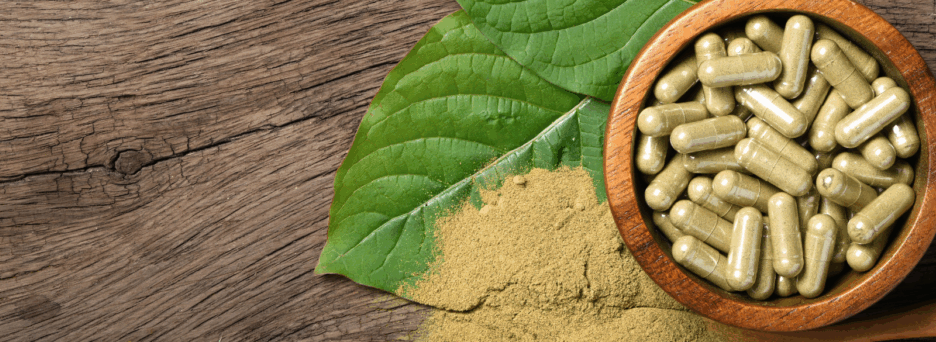BLOG
Kratom Derivative Is the Latest ‘Legal High’ of Concern

An alarmingly potent opioid agonist synthesized from kratom leaves and sold in vape shops and gas stations has addiction psychiatrists calling for an overhaul of the way dietary supplements and additives are regulated.
Addiction psychiatrists and the Food and Drug Administration (FDA) are raising alarm bells about 7-OH, a new opioid more potent than morphine that is sold online, in vape shops, and at gas stations.
“I hear about kratom or 7-OH all the time now from patients and other providers. Folks come into our clinic dependent on it,” said Lief Fenno, M.D., Ph.D., chair of APA’s Council on Addiction Psychiatry. “We need to warn clinicians to keep an eye out for it, including pediatricians and general practitioners, and to make sure that psychiatrists are familiar with it and are asking their patients about it.”
Amping Up the 7-OH:
7-OH starts with the leaves of Mitragyna speciosa, or kratom, a tropical evergreen tree in the coffee family that grows in Southeast Asian wetlands. Kratom leaves have been used in traditional medicine for centuries. Their primary psychoactive substances are mitragynine and 7-hydroxymitragynine (7-OH), though the latter makes up just 2% of kratom leaves’ total alkaloid content.
But today’s manufacturers can amp that way up by converting kratom’s abundant levels of mitragynine into 7-OH, which is then blended into tablets, gummies, drink mixes and shots, and even faux ice cream cones. The resulting spiked or enhanced products being sold over the counter may have 7-OH concentrations 500% greater than what’s found in kratom leaves, according to the FDA. These opioids are marketed to ease opioid withdrawal, anxiety, depression, and fatigue, and sometimes to promote weight loss.
“Vape stores are popping up in every neighborhood in America, and many are selling addictive products like concentrated 7-OH. After the last wave of the opioid epidemic, we cannot get caught flat-footed again,” wrote FDA Commissioner Marty Makary, M.D., M.P.H., in a media release.
“7-OH has a very similar brain receptor profile to other opioids; it’s a full agonist to the μ-opioid receptor,” said Fenno, an assistant professor of psychiatry and behavioral sciences at the University of Texas at Austin. “In animal models, rodents can’t tell the difference between morphine and 7-OH.”
In late July, the FDA issued a letter to physicians warning of the surge in availability of 7-OH products and related adverse events. “Aside from addiction, 7-OH side effects include withdrawal symptoms, insomnia and anxiety, seizures, and fatal respiratory depression,” the agency wrote. The FDA also noted that it was moving forward with a plan to reschedule certain 7-OH products as controlled substances.
Meanwhile, calls to Poison Control centers across the country have been spiking, with 1,690 kratom-related cases logged in the first seven months of 2025, more than the previous full year. Since adding a classification code in February for logging 7-OH-related calls, the National Poison Data System has noted that 40% of kratom cases specifically involved abuse of 7-OH.
ASSESSMENT & TREATMENT
“Kratom is marketed as if it’s a cool, hip, fun, trendy thing, and it’s legal, so it’s readily accessible,” said Elie G. Aoun, M.D., a general, addiction, and forensic psychiatrist and assistant professor of clinical psychiatry at Columbia University. “This gives people the impression that it’s safe, when in fact it’s … addictive.” The patients with kratom addiction that Aoun is seeing fall into two camps. “About half of the people … are young and have no prior experience with opioids,” he said. The other half have a history of opioid addiction and use kratom to reduce their heroin or oxycodone use. “But because kratom is not a medication or a treatment, it doesn’t help them. So, they end up going back and forth between traditional opioids and kratom.”
“Kratom is marketed as if it’s a cool, hip, fun, trendy thing, and it’s legal. This gives people the impression that it’s safe, when in fact it’s causing people to develop an addictive disorder,” said Elie G. Aoun, M.D.
Research on kratom’s effects, prevalence, and treatment is limited. “The most important thing doctors can do is ask our patients about kratom use in the same way that we ask patients about alcohol or cigarettes,” Aoun said. For individuals who acknowledge using the drug, clinicians should educate them about its risks and encourage them to quit. “Very often, patients don’t realize that they’re taking something that’s akin to a traditional opioid. Physiologically, kratom is not much different than oxycodone or heroin.”
Particularly with young and inexperienced patients, Aoun starts with supportive management, motivational interviewing, and psychotherapy. He’s found that involving patients’ families can be very useful. This behavioral approach works in about half of cases. For the rest, Aoun prescribes naltrexone or even Suboxone (buprenorphine/naloxone). “It’s extremely effective, but it is basically a lifelong, indefinite treatment.”
Fenno said that APA is working with the American Society of Addiction Medicine and the American Academy of Addiction Psychiatry to discuss the possible creation of formal treatment guidelines. Psychiatrists are also calling for the federal government to clarify whether kratom is officially designated as an opioid for the purposes of diagnosis, treatment, and billing. Doing so would give patients full access to the range of addiction treatments.
Tackling 7-OH, Allowing Kratom?
Kratom products started becoming a problem in the United States about 10 years ago, with an uptick in complaints regarding kratom-related addiction, psychosis, tachycardia, and deaths. In August 2016, the Drug Enforcement Administration (DEA) filed a notice to schedule kratom’s psychoactive compounds on a temporary basis to avoid “an imminent hazard to public safety.” Kratom users, researchers, and industry groups including the American Kratom Association and the Botanical Educational Alliance mounted strong objections, and 50 members of Congress opposed the measure. Just two months later, the DEA withdrew the notice.
“Folks come into our clinic dependent on [kratom and 7-OH]. We need to warn clinicians to keep an eye out for it and to make sure that psychiatrists are familiar with it and are asking their patients about it,” said Lief Fenno, M.D., Ph.D.
Since then, a patchwork of state and local laws and regulations have cropped up that attempt to regulate kratom and its primary psychoactive alkaloids. At least six states have fully banned them—Alabama, Arkansas, Indiana, Louisiana, Vermont, and Wisconsin. Rhode Island had also banned it, but recently backtracked to allow for sales of kratom—but not 7-OH or other concentrates—starting in 2026.
Aoun and Fenno are skeptical of the FDA’s current plan to schedule 7-OH but not kratom-leaf products. “There are no medically approved uses for kratom or any kratom derivative,” Fenno said. “So, saying that there’s a threshold concentration [of 7-OH], above which it’s dangerous and below which it’s not, I don’t think is workable…. Who would approve the labeling of a substance that is not, according to FDA, fit for human consumption? Who would do quality control?”
Aoun has a similar view. “That would be arguably even more dangerous,” he said, “because you’d be telling people that kratom is safe and 7-OH is not, when in fact both are causing people to have an addiction.”
DIFFERENT DRUG, SAME STORY:
Just one year ago, APA’s Council on Addiction Psychiatry warned about the dangers of tianeptine, another opioid-like drug dubbed “gas station heroin” found in over-the-counter products. Other harmful, lab-concocted drugs of abuse that have been marketed as “legal highs” include bath salts (synthetic derivatives of cathinone), spice/K2 (synthetic cannabinoids), and extracts of salvia; Aoun wrote a report about these for the Rhode Island Medical Journal after a spate of 10 drug-induced deaths in the state.
“We’re always behind the eight ball. We’re always trying to catch up and figure out how drug dealers are modifying a given drug or herb” to skirt the law,” Aoun said. “Ultimately, the labs that are synthesizing these drugs and the dealers are being smarter than the government.”
Aoun called for an overhaul of the Controlled Substances Act to provide legislators and regulators with more flexibility to act. “Unless there’s a reform to how we think about what a controlled substance is, what’s legal and what’s illegal, we’re going to continue having the same issue,” he said. “… It’s never going to stop.”
Fenno also called for a new regulatory plan. “Our approach to regulating dangerous chemicals is to wait until there’s a demonstrated problem before we put into place the policies that can protect our children and patients,” he said. “That’s backwards from how we regulate prescription pharmaceuticals, where they can’t be sold to patients until they’re proven to be safe.”
Visit Our Blog
